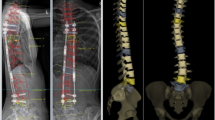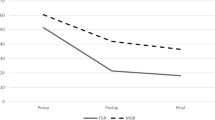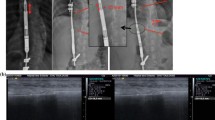Abstract
Objective
To quantitatively determine the relationship between the contouring of the magnetically controlled growing rods (MCGR), their expansion capacity and the risk of developing proximal junctional kyphosis in early onset scoliosis (EOS).
Summary of background data
MCGRs allow gradual expansion and correction of the spinal deformity in EOS while reducing the need for repeated surgeries. As the expansion of the MCGRs is controlled externally, several factors can impact the discrepancy between the intended and actual expansions of the rods. The expansion capacity of the growing rods as a function of the expanded length has been tested in experimental setups; however, no study has evaluated the role of contouring of the MCGRs on its function and long-term surgical outcome.
Methods
A total of 25 EOS patients, a total of 48 MCGRs, with right thoracic curves, were studied retrospectively. All patients had two view spinal radiographs at pre-operative, after MCGR implantation, and after 6 lengthening visits. The first post-operative radiographs were used to calculate the 3D contour of the MCGR at the proximal end. 2D ultrasound images before and after lengthening visits were used to measure the rod lengthening at each visit. The relationship between the increase in the rod length and rod curvature was determined. Finally, the rod curvature was correlated to the changes in proximal junctional kyphosis (PJK) angle between the pre-operative and the most recent follow-up, i.e., after 6 visits.
Results
The average rod 3D angle at the proximal end was 13.5° ± 9.7° [0°-37.2°]. The overall increased length after six lengthening visits for the rod at the concave side was 18.8 mm and at the convex side was 16.9 mm. 62% of the patients with a contoured rod at the proximal end developed a PJK exceeding 10° whereas in patients with a straight rod PJK occurred in 9.1%.
Conclusions
Contouring the MCGR impacts both the mechanics of the rod expansion and the prevalence of PJK in EOS patient population.




Similar content being viewed by others
References
Harrington PR (1963) Scoliosis in the growing spine. Pediatr Clin North Am 10:225–245
Samdani AF, Ranade A, Dolch HJ et al (2009) Bilateral use of the vertical expandable prosthetic titanium rib attached to the pelvis: a novel treatment for scoliosis in the growing spine. J Neurosurg Spine 10(4):287–292
Yazici M, Emans J (2009) Fusionless instrumentation systems for congenital scoliosis: expandable spinal rods and vertical expandable prosthetic titanium rib in the management of congenital spine deformities in the growing child. Spine (Phila Pa 1976) 34(17):1800–1807
Akbarnia BA, Pawelek JB, Cheung KM et al (2014) Traditional growing rods versus magnetically controlled growing rods for the surgical treatment of early-onset scoliosis: a case-matched 2-year study. Spine Deform 2(6):493–497
Helenius IJ (2020) Standard and magnetically controlled growing rods for the treatment of early onset scoliosis. Ann Transl Med. 8(2):26
Akbarnia BA, Mundis GM (2019) Magnetically controlled growing rods in early onset scoliosis: indications, timing and treatment. Orthopade 48(6):477–485
La Rosa G, Oggiano L, Ruzzini L (2017) Magnetically controlled growing rods for the management of early-onset scoliosis: a preliminary report. J Pediatr Orthop 37(2):79–85
Bekmez S, Dede O, Yataganbaba A, Demirkiran HG, Yazici M (2020) Early results of a management algorithm for collapsing spine deformity in young children (below 10-year old) with spinal muscular atrophy type II. J Pediatr Orthop 40(6):e413–e419
Fedorak GT, Garg S, Heflin JA, Smith JT (2020) Management of early-onset scoliosis-from mehta casts to magnetically expandable rods: state of the art in 2019. Instr Course Lect 69:641–650
Bauer JM, Yorgova P, Neiss G et al (2019) Early onset scoliosis: is there an improvement in quality of life with conversion from traditional growing rods to magnetically controlled growing rods? J Pediatr Orthop 39(4):e284–e288
Beaven A, Gardner AC, Marks DS, Mehta JS, Newton-Ede M, Spilsbury JB (2018) Magnetically controlled growing rods: the experience of mechanical failure from a single center consecutive series of 28 children with a minimum follow-up of 2 years. Asian Spine J. 12(5):794–802
Studer D, Heidt C, Büchler P, Hasler CC (2019) Treatment of early onset spinal deformities with magnetically controlled growing rods: a single centre experience of 30 cases. J Child Orthop 13(2):196–205
Gilday SE, Schwartz MS, Bylski-Austrow DI et al (2018) Observed length increases of magnetically controlled growing rods are lower than programmed. J Pediatr Orthop 38(3):e133–e137
Cheung JPY, Yiu K, Kwan K, Cheung KMC (2019) Mean 6-year follow-up of magnetically controlled growing rod patients with early onset scoliosis: a glimpse of what happens to graduates. Neurosurgery 84(5):1112–1123
Rushton PRP, Smith SL, Forbes L, Bowey AJ, Gibson MJ, Joyce TJ (2019) Force testing of explanted magnetically controlled growing rods. Spine (Phila Pa 1976) 44(4):233–239
Poon S, Spencer HT, Fayssoux RS, Sever R, Cho RH (2018) Maximal force generated by magnetically controlled growing rods decreases with rod lengthening. Spine Deform 6(6):787–790
Agarwal A, Kelkar A, Garg Agarwal A, Jayaswal D, Jayaswal A, Shendge V (2020) Device-related complications associated with magec rod usage for distraction-based correction of scoliosis. Spine Surg Relat Res. 4(2):148–151
Ahmad A, Subramanian T, Panteliadis P, Wilson-Macdonald J, Rothenfluh DA, Nnadi C (2017) Quantifying the ‘law of diminishing returns’ in magnetically controlled growing rods. Bone Joint J 99-B(12):1658–1664
Sankar WN, Skaggs DL, Yazici M et al (2011) Lengthening of dual growing rods and the law of diminishing returns. Spine (Phila Pa 1976) 36(10):806–809
Gardner A, Beaven A, Marks D, Spilsbury J, Mehta J, Newton EM (2017) Does the law of diminishing returns apply to the lengthening of the MCGR rod in early onset scoliosis with reference to growth velocity? J Spine Surg 3(4):525–530
Author information
Authors and Affiliations
Corresponding author
Ethics declarations
Conflict of interest
No benefits in any form have been or will be received from a commercial party related directly or indirectly to the subject of this manuscript. SP received funding from the scoliosis research society outside of scope of this work. PFS received personal fees from DePuy, Medtronic Sofamor Danek, and NuVasive outside of scope of this work.
Additional information
Publisher's Note
Springer Nature remains neutral with regard to jurisdictional claims in published maps and institutional affiliations.
Institutional Review Board: Policies and procedures at participating institutions were followed. No benefits in any form have been or will be received from a commercial party related directly or indirectly to the subject of this manuscript.
Rights and permissions
About this article
Cite this article
Pasha, S., Sturm, P.F. Contouring the magnetically controlled growing rods: impact on expansion capacity and proximal junctional kyphosis. Eur J Orthop Surg Traumatol 31, 79–84 (2021). https://doi.org/10.1007/s00590-020-02743-x
Received:
Accepted:
Published:
Issue Date:
DOI: https://doi.org/10.1007/s00590-020-02743-x




